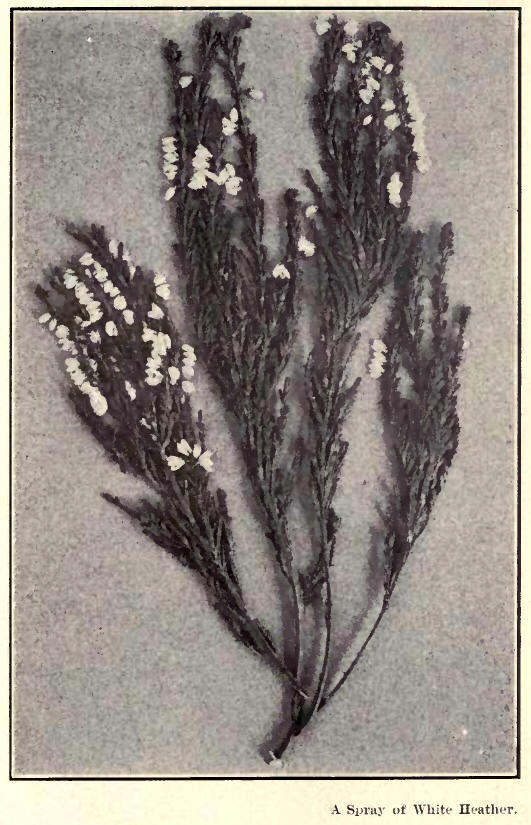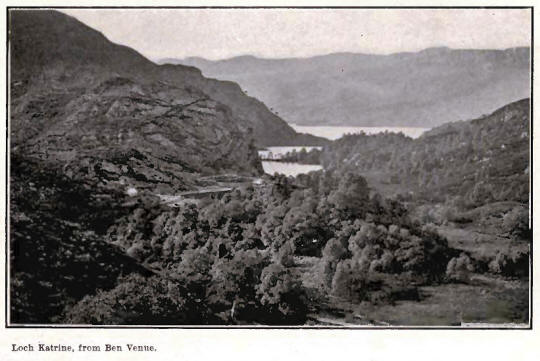|

"Awake ye light fairies that trip o'er the
Heather—Hogg.
River Spirit. Sleep'st
thou, brother?
Mountain Spirit.
Brother, nay—
On my hills the moonbeams play.
From Craig-cross to Skelfhill-pen,
By every rill, in every glen,
Merry elves their morrice pacing,
To aerial
minstrelsy,
Emerald
rings on brown heath tracing,
Trip it deft and merrily.
Up, and mark their
nimble feet;
Up, and list their music sweet.
—Lay of the Last Minstrel.

FAIRIES are generally believed to inhabit all
campanulate flowers, and many references occur both in the prose and
poetry of Scotland to the presence of these elfin folk in Heather bells.
Like the feld elfin of the Saxons, the usual dress
of the fairies was said to be green, though on the moors they have
sometimes been observed in heath-brown, or in weeds dyed with the
stone-row or lichen. Their dwellings were the fairy hillocks or tomhans,
which Mrs. Grant of Laggan says were conical shaped, rising in dry
gravelly ground and thickly covered with Heath.
Geikie thus describes their haunts: "The mounds
rose so conspicuously from the ground, and whether in summer heat or
winter frost, wore ever an aspect so smooth and green, where all around
was rough with dark moss-bags and sombre moor, that they seemed to have
been raised by no natural power, but to be in very truth the work of
elfin hands, designed at once to mark and guard the entrance to the
fairy world below. The hapless wight who, lured by their soft verdure,
stretched himself to sleep on their slopes, sank gently into their
depths, and after a seven years' servitude in fairyland awoke again on
the self-same spot."
Mrs. Grant furnishes the following legend
concerning one of these fairy hillocks, from which the Highlanders were
accustomed in their solitude to hear issuing "the music of small sweet
pipes";
"A little girl had been innocently loved by a
fairy who dwelt in a tomhan near her mother's habitation. She had three
brothers who were the favorites of her mother. She herself was treated
harshly and taxed beyond her strength; her employment was to go every
morning and cut a certain quantity of turf from dry, heathy ground for
immediate fuel; and this with some uncouth and primitive implement. As
she passed the hillock which contained her lover, he regularly put out
his hand with a very sharp knife of such power that it quickly and
readily cut through all impediments. She returned cheerfully and early
with her load of turf, and as she passed by the hillock she struck on it
twice and the fairy stretched out his hand and received the knife.
"The mother, however, told the brothers that her
daughter must certainly have had some aid to perform the allotted task.
They watched her, saw her remove the enchanted knife and forced it from
her. They returned, struck the hillock as she was wont to do, and when
the fairy put out his hand, they cut it off with his own knife. He drew
in the bleeding arm in despair; and supposing this cruelty was the
result of treachery on the part of his beloved, never saw her more."
Professor John Wilson, in his "Lay of Fairy Land,"
accounts for the disappearance of the widow's daughter in this wise:
Some thought that Fhaurn, the savage shape that on
the mountain dwells,
Had somewhere left her lying dead among the
heather bells
And when at last she returned, though
The heather
balm is fragrant—the heather bloom is fair,
But 'tis neither heather
balm nor bloom that wreathes round Mhairi's hair;
but the flowers that grew in the garden of
Fairyland, where, evidently, Heather finds no place.
The Ettrick Shepherd, in his tale of the recapture
of Anne of Raeburn from the fairies, says that when
The evening fell so sweetly still,
So mild on
lonely moor and hill,
The little genii of the fell
Forsook the
purple heather bell.
And the elves never returned; for, continues the
poet:
E'er since, in Ettrick's glens so green,
Spirits, though there, are seldom seen;
And fears of elf and fairy
raid,
Have like a
morning dream decayed.
The barefoot maid of rosy hue,
Dares from the heath flower brush the dew,
To
meet her lover in moonlight still,
By flowery den, or tinkling rill;
And well dares she till midnight stay
Among
the coils of fragrant hay.
The favorite food of the fairies was said to be
Scotch scones and Heather honey and a bowl of cream —a dainty morsel,
forsooth!
Ossian tells us that "It was the opinion of the
times that the souls of heroes went immediately after death to the hills
of their country, and the scenes they frequented the most happy time of
their life. It was thought, too, that dogs and horses saw the ghosts of
the deceased."
"My ghost o'Connall is on my native hills, but my
corse is on the sands of Ulhin. Thou shalt never talk with Crugal, or
find his lone steps in the heath."
This reference to tracing footsteps on the Heath
may be explained by the following statement by Burt. He says: "By the
way the Heath, or Heather, if pressed by the foot, retains the
impression, or, at least, some of it, for a long while before the
Heather rises again effectually. A single Highlander has been found by
the track of his foot when he took to hills out of the common way for
his greater safety in his flight."
An old superstition was prevalent in the North of
Scotland that the fairies became incensed whenever Heather was taken
from their hillocks, and in the dwellings where such Heather was stored
the inmates had but little happiness.
From "Hardmore"
Traditional meeting place of Macbeth and Banquo
with the Weird Sisters.
* * * * *
Thin and black along
The shivering grass the heather holds its breath
For fear, and cannot burn and blossom when
Night after night
such awful sights it sees.
—Cora Kennedy Aitken.
|
